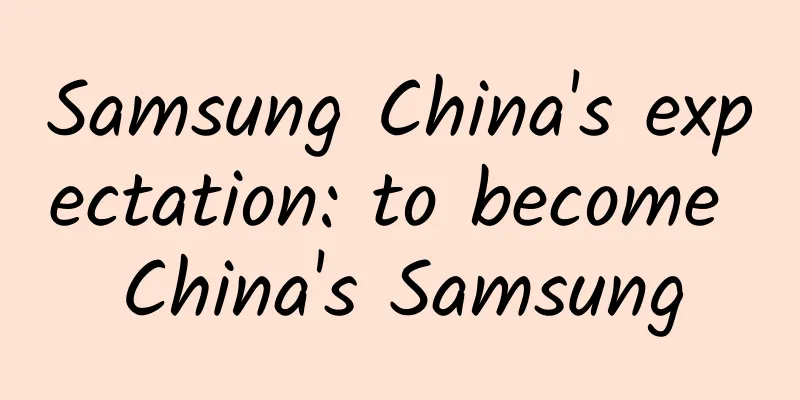Samsung China's expectation: to become China's Samsung

|
Samsung Electronics has always paid close attention to the policies and trends related to listing in China. The importance of China to Samsung is self-evident. In fiscal year 2013, the Chinese market brought Samsung Electronics a net sales of RMB 254.5 billion, a year-on-year increase of 80%. Although the Chinese market (18% of sales) still does not account for Samsung Electronics' sales in the United States (30% of sales), Europe (23% of sales), and Asia and Africa (19% of sales), its growth potential has far exceeded its previous emerging market positioning. Samsung Electronics Vice Chairman Lee said at the Boao Forum for Asia in April this year that the global smartphone development speed is likely to slow down and will not continue to grow as it has in the past seven years, with the exception of China. Because China's three major operators have the task of accelerating 4G network coverage this year, the market will continue to drive the development of smartphones, and the future will not be double-digit, but triple-digit growth. Against this background, in June 2014, Wang Tong, executive vice president of Samsung Electronics Greater China, replaced Lee Jin-joong as president of Samsung Greater China Mobile Communications Business. In order to achieve localization, Samsung is exploring new strategies that are in line with the Chinese government's new industrial policies and can enable the company to take off again in China. First, Samsung shifted the focus of its business in China from simple assembly manufacturing to capital-intensive cutting-edge technology industries. It continuously expanded its technology investment and significantly strengthened the layout of the entire industry chain of design, R&D, production, marketing, and customer service in China. Second, in the early days of entering China, Samsung focused mainly on the eastern coastal areas in order to achieve exports. Now it will massively increase investment in the central, western and northeastern regions. Finally, in order to comply with the government's policy of comprehensively deepening reforms in the fields of finance, culture, medical care, construction, etc., Samsung will also expand its business focus from the electronics-based industrial layout to various fields such as finance, medical care, and urban construction. Becoming "China's Samsung" "If someone asks me if Samsung Electronics can become a Chinese company, I can definitely say yes." In late April, Samsung Electronics CFO Lee Sang-hoon sat in a conference room at the headquarters building in Seocho, Seoul, South Korea, and pointed to his hair and said, "We look the same." Li Xiangxun told Caijing that Samsung wants a bigger market and wants to do business with 1.3 billion people. In fact, since the restoration of diplomatic relations between China and South Korea in 1992 and Samsung's entry into China, the Chinese market has always been positioned as Samsung's "second home market". When interviewed by Caixin at the headquarters in Seocho, Seoul, Kwon Oh-hyun, Vice Chairman and CEO of Samsung Electronics, once again conveyed Chairman Lee Kun-hee's wishes, "The Chairman told us that China is another local market for Samsung, and we must also contribute to China. This is Samsung's goal and also the goal of our Chairman." Vice Chairman Quan Wuxuan also emphasized: "We must become a company that contributes to China." Samsung China’s senior management always reminds the outside world repeatedly when communicating with the outside world: We are Samsung China, not Samsung China. As a company with strong strategic choices and management capabilities, Samsung has never changed its positioning in the Chinese market. This is in contrast to the previous wavering of many multinational electronics giants in the Chinese market. Most industry insiders believe that Sony was surpassed by Samsung in a very short period of time, largely because it did not pay enough attention to the Chinese market. Apple was initially hesitant about entering China, and only began cooperating with China Mobile last year . This overly cautious strategy caused it to miss the best time to gain market share. In 2013, Apple ranked only fifth in China in terms of sales, with Samsung ranking first. The latest data from the first quarter of 2014 shows that Xiaomi's sales in China exceeded Apple's 9 million units with 10.4 million units sold in the quarter. According to Strategy Analytics, sales of portable devices in the Chinese market will reach 430 million units in 2014, surpassing the United States (163 million units). Samsung's clear understanding of this trend is obviously better than many of its peers. Previously, Apple and Sony both listed China as the most important market on par with the United States after years of hesitation, but it was obviously too late. Currently, 23 companies under Samsung Group have entered China, with more than 120,000 employees in China, accounting for 30% of the global total. Samsung Electronics has 13 factories, 7 R&D centers and 1 design center in China, with 7,000 domestic R&D personnel, of which 4,000 have joined Samsung in the past three years. In 2013 alone, Samsung China established three new research institutes in Shenzhen and Xi'an. China used to be the base for Samsung's export processing trade, but now the integrated system of design, R&D, production and sales has been transferred to China. Wang Tong, who has recently joined the core leadership of Samsung Group and is the highest-ranking Chinese executive in Samsung, said in an interview with the media earlier this year that the Chinese market is no longer a distant emerging market belonging to the future, but one of the most important markets at present. He also admitted that Samsung also viewed China as an emerging market in the early days, but did not expect it to develop so rapidly. Fortunately, Samsung has made a good layout. At Samsung in China, Chang Won-ki, president of Samsung Group Greater China, requires employees to communicate in Chinese, believing that this can improve work efficiency. This Korean executive can now basically communicate with Chinese people without a translator. This is much more friendly than the management of Apple China, which has never appeared in front of the Chinese media. It is not difficult to see that in almost all aspects that can be perceived by the outside world, Samsung wants to behave more like a local Chinese company, which is rare among multinational companies of the same size. Local strategy and Samsung-style management Wang Tong once told the media that the highest level of localization is ultimately reflected in talent, decision-making mechanisms and voice. What Samsung emphasizes internally is that "Chinese business should be managed by Chinese people, and Chinese people should develop, produce and sell products themselves to achieve true localization." Changes have quietly taken place in Samsung China. Originally, the heads of each product department were all Koreans. Starting in 2012, the heads were changed to Chinese and Koreans were vice heads. The Chinese had the power to make business decisions, while the Koreans only assisted them in conducting business. Their internal ranks were also lower than those of the heads, and some were even deputy heads. This personnel management system also experienced pain during the integration period, but it eventually survived and is now operating well. Peng Yu, deputy general manager of China Market Research Group, has frequent contact with Samsung internal personnel. He told Caixin reporters that it is certain that Chinese people are better at solving Chinese problems. The rapid growth of Samsung China in home appliances such as refrigerators and washing machines in the past two years is related to these management changes. According to data provided by iiMedia Research, from January to April 2014, Samsung refrigerator sales in the Chinese market increased by 21% year-on-year, while Siemens, which ranked first in market share among foreign brands, decreased by 10% year-on-year; Samsung washing machine sales increased by 19% year-on-year, while Siemens decreased by 3% year-on-year. A former Chinese employee of Samsung Electronics said that Samsung's goal for white goods in China is to surpass Siemens and become the number one foreign brand. He believes that Samsung will achieve the goal soon. Peng Yu agrees with him. Samsung has firmly taken the top spot in sales among foreign brands in the Chinese color TV market, nearly 2 percentage points higher than the second-ranked Sharp. In the ranking of sales volume in the entire Chinese color TV market, Samsung is only ranked sixth, but it ranks second in sales revenue, 3 percentage points behind the first-ranked Hisense. Due to its thorough localization, Samsung's policy and market research in China is clearly ahead of its peers and has benefited substantially from it. In November 2013, Samsung and China Mobile jointly launched the TD-LTE mobile phone (China's 4G mode with independent intellectual property rights), which was also the first TD-LTE mobile phone in China. This is not only related to Samsung's experience in the international LTE market, but more importantly, its understanding of China's policies and its quick action. At that time, Samsung made a decision without any market signs, judging that the Chinese government's driving force and the development momentum of TD-SCDMA frequency technology should not be underestimated. In the absence of any LTE market, Samsung continued to invest in it. Today, the main dividend of the Chinese mobile phone market comes from the transition from 3G to 4G, and currently only LTE is available. In hindsight, the industry has to admit that Samsung's judgment was extremely accurate. For many years, Samsung has been adhering to two major strategies in China: the first is to launch new products in the Chinese market as synchronously as possible with other countries; the second is to specifically research and develop products suitable for Chinese consumers. Among its international peers, Samsung was the first to realize the "19 rule" of the Chinese smartphone market, namely: 10% are mid- to high-end users, and 90% are mid- to low-end users. As a market-oriented company, Samsung directly targets different user groups through mobile phones with different prices and selling points. In terms of products, it covers a full range of products from 1,000 yuan to 10,000 yuan, and has launched products covering the three major formats to meet market demand. Samsung's ability to continue to adopt the strategy of flooding the market with devices lies in its ability to integrate the vertical industry chain, which has already been replicated in China, including the 8.5-generation LCD panel production line in Suzhou and the 10-nanometer semiconductor memory chip factory in Xi'an that was put into production in May, both of which represent the world's highest level in their respective fields. While Samsung has implemented a full localization strategy in China, it has not diluted its inherent genes and culture. In essence, it is still a multinational company based in South Korea. An employee of Samsung in China gave an example to the reporter of Caijing: At Samsung, if the superior speaks loudly to the subordinate, the subordinate will feel very embarrassed. This is the authentic Korean management style. In Chinese companies that increasingly advocate American management, the boss and the subordinate can even point at each other and curse each other, and then everything will be fine. Samsung implements the "Chinese Minister + Korean Deputy Minister System" in China, which is also a persistence in its culture and management to a certain extent, and is a more mature management balance. One of the important reasons why Sony has not developed as rapidly as Samsung in China is that Sony's local strategy is too extreme, over-reliant on local teams, and lacks necessary control. As a result, many important positions are held by Chinese, and the headquarters has lost control over resource integration and internal coordination. Samsung's unique "triangle management structure" that has been written into many management textbooks has also been completely copied to China. Samsung (China) Investment Co., Ltd. is equivalent to the downward extension of Samsung Group, reporting to the Future Strategy Office of the Korean headquarters, and Samsung Electronics Greater China, as a business line, reports directly to Samsung Electronics Korea headquarters. Therefore, with the family core as the apex, the Future Strategy Office and professional managers at the product execution level as two lines of support, a "triangle management structure" has also been formed in China. This management structure has both advanced strategic intentions and strong execution capabilities. Samsung is a company that looks very "Chinese", but its management culture is very unique and the choices it makes are quite meaningful. Expectations for listing in China With great ambitions in China, Samsung has made localization through listing in the Chinese capital market an important part of its development strategy. Through listing, it can achieve deep integration with the Chinese capital market, make the company more transparent, and attract more Chinese investors. At the same time, it can also open up direct financing channels in China in the future, reinvest the raised funds in China, share the profits with Chinese investors, and then build a full industry chain business layout covering R&D, production, sales, and customer management. However, unlike some overseas companies that are eager to raise funds in China, Samsung is not eager to conduct direct financing in China in the short term. So far, Samsung has invested tens of billions of US dollars in China, mainly with its own funds and partly with bank loans. However, considering the company's sustainable development, opening up direct financing channels other than bank loans is also a necessary strategic arrangement. So, is it possible for Samsung Electronics to be listed in China in some appropriate way? It is reported that since 2008, relevant regulatory authorities of the securities market have conducted demonstration and research on the introduction of high-quality overseas companies to be listed in China. Important technical issues in accounting, law, issuance, listing, trading, settlement, etc. have been fully discussed. Under the current legal and regulatory framework, technical difficulties have been preliminarily eliminated. On this basis, the CSRC has completed the draft rules for the domestic listing of overseas companies in the early stage, and has achieved important phased results, but there is no specific timetable. As China becomes the world's second largest economy, the financial market must also increase its international influence to match the status of the economic scale. This requires China's financial market to give full play to the role of capital support, further open up and gradually achieve integration with the world. Building Shanghai into an international financial center has become a national policy of China. In April 2009, the State Council issued a document announcing that Shanghai would be built into an international financial center by 2020. By introducing high-quality overseas companies to be listed on the Shanghai Stock Exchange, it will provide strong support for the ultimate realization of Shanghai's goal of building an international financial center. Despite this, the Shanghai Stock Exchange's international board, which was once highly anticipated, has not yet been launched, and the market is concerned that overseas companies' listings may divert market funds. At the same time, the internationalization of the RMB is still in progress, and how to properly price and control funds for overseas companies listed in China also involves relatively complex financial regulatory coordination. Relevant personnel of the China Securities Regulatory Commission responded to Caijing reporters that there is no news about the international board. It is reported that one of the concerns of the regulatory authorities is that the listing of foreign companies in China will bring more bubbles to the immature Chinese capital market, and Chinese companies may be squeezed. From the overall arrangement, the launch of the Shanghai Stock Exchange International Board should depend on the degree of opening of the RMB capital account. Cao Yuanzheng, chief economist of the Bank of China, once said that the best option should be to fully convert the RMB under the capital account and launch the International Board; the second best option is to establish an international board market denominated in RMB overseas, which will have a smaller impact on the capital account. Samsung's internal analysis believes that the external conditions for overseas companies to list and issue stocks in China have matured to a certain extent. Some industry insiders also believe that the Chinese capital market should give special consideration to overseas companies such as Samsung that do have long-term investment and development strategies in China, without waiting for the international board to act in a unified manner. Instead, a better approach is to mature one, pilot one, try it locally, and then promote it on a large scale. The scale of China's securities market has ranked among the top in the world. At the end of 2013, the total market value of China's securities market reached 3.95 trillion US dollars, ranking fourth in the world after the United States, Japan and the United Kingdom. In the past few years, the structure of China's securities market has been further deepened and developed, the multi-level capital market has begun to take shape, and the market mechanism has been gradually improved. The gradual development of China's securities market has accumulated valuable experience for the internationalization of the market. At present, regulatory agencies are also further promoting the reform of the securities market. These factors have laid a solid foundation for the internationalization of the securities market and for meeting the financing needs of overseas enterprises. Samsung has no clear financing needs in China, but from the trend point of view, by listing on the China International Board, Samsung and other overseas companies "excellent students" can obtain a stable source of funds, that is, the funds needed to expand the scale of business in China in the future can be realized through direct financing in the securities market, thus overcoming the restrictions that overseas companies have to rely on indirect financing such as loans. By listing, high-quality international brands such as Samsung can gain more public support, tying their interests with those of Chinese investors, and also helping to increase Chinese consumers' loyalty to these brands. A comparable mobile phone company is ZTE, which is listed in Shenzhen. On June 19, the company's price-earnings ratio was as high as 18.14 times, more than twice that of Samsung Electronics (7.09). If it were to list in China, Samsung Electronics' market value would be enlarged, and it is expected to approach or even exceed Apple's market value. Samsung Electronics may be listed on the Chinese A-share market by issuing Chinese Depository Receipts (CDRs). If it is listed in this form, the corresponding depository institution must be determined. Samsung said there is no news yet. By the end of 2013, Samsung's total investment in China reached 16.8 billion US dollars. In July 2014, President Xi Jinping visited South Korea alone for the first time after taking office and visited Samsung's exhibition hall. In the eyes of capital market people, these are all positive factors for Samsung Electronics to go public in China. As for the specific feasible path to go public, Caijing learned that it is still under discussion and communication with relevant institutions. Under the existing system and mechanism, it is not impossible to design a listing channel. Chinese companies approach Samsung is full of expectations for the Chinese market and is also driven by the pressure of market competition. The latest data from market research firm Kantar shows that in April this year, Xiaomi's sales in China surpassed Samsung for the second time after October last year. Whether this overtaking will become a regular phenomenon is still controversial, but the rising momentum of Chinese competitors is obviously not something Samsung can ignore. Xiaomi has seized the market with its combination of software and hardware. In just four years since its establishment, its mobile phone sales reached 19 million units in 2013, and its founder Lei Jun expects sales to reach 40 million units in 2014. This has put great pressure on Samsung and other hardware giants. Samsung was the first to launch TD-LTE phones in China. As of the end of May, Samsung had launched seven 4G phones and did not expand its product line downward. However, data from the Ministry of Industry and Information Technology on mobile phone network access shows that there are currently more than 170 TD-LTE phones. Samsung phones need to stand out in order to maintain their market position. Recently, the Korea Industrial Technology Evaluation and Management Institute evaluated the technology levels of countries around the world in the field of technology. The statistical results show that the technology gap between China and South Korea has been greatly reduced. In the display field, the gap between South Korea and China has narrowed from 26.9 points in 2011 to 19.3 points last year. It's not just the mobile phone market that is being challenged; Samsung is facing challenges from Chinese companies in all product areas. In January 2012, Samsung Electronics and LG Electronics took the lead in launching curved LED TVs at the home appliance exhibition. However, just one year later, Chinese brands launched a massive challenge to the two electronics companies, with TCL, Hisense, Haier and Konka launching similar products. Samsung once tried to widen the gap with Chinese companies in OLED TVs. However, for various reasons, Samsung strategically retained its investment in large-size OLEDs, while focusing on the UHD market. This gave Chinese companies unlimited opportunities. Wu Yande, vice president of Visionox, a Chinese company specializing in the production of small-size OLED panels, told Caixin reporters that the Chinese government is formulating relevant policies to vigorously support the domestic display panel industry, and the industry is very much looking forward to it. A more vivid evaluation is that Chinese companies are just like Samsung more than a decade ago, copying the model of the first place and trying to quickly surpass the first place. It may become increasingly difficult for Samsung to maintain its leading position in its existing product areas. However, the electronic consumer field has never developed in a single line, and such a challenge may also become an opportunity for Samsung to leap forward again. Everything depends on how Samsung acts. As a winner of Toutiao's Qingyun Plan and Baijiahao's Bai+ Plan, the 2019 Baidu Digital Author of the Year, the Baijiahao's Most Popular Author in the Technology Field, the 2019 Sogou Technology and Culture Author, and the 2021 Baijiahao Quarterly Influential Creator, he has won many awards, including the 2013 Sohu Best Industry Media Person, the 2015 China New Media Entrepreneurship Competition Beijing Third Place, the 2015 Guangmang Experience Award, the 2015 China New Media Entrepreneurship Competition Finals Third Place, and the 2018 Baidu Dynamic Annual Powerful Celebrity. |
>>: Samsung Galaxy S5 completes ice bucket challenge, names iPhone 5S and other phones
Recommend
The differences between Android and iOS are getting smaller and smaller, but the latter does not do as well in security and other features
The debate over the iPhone and Android flagships ...
How many steps are needed to neatly fold three parachutes the size of basketball courts and put them into the return capsule?
The main parachute has an area of 1,200 square ...
How to prevent posting on Tieba from being deleted (Tips on preventing posting in batches from being deleted on Tieba)
Now, posting in batches on Tieba requires a chang...
Product premium: HR asks you to sell a bottle of mineral water for 300 yuan, how do you sell it?
This question has 7,915 followers on Zhihu. To be...
54 lessons required for training managers: a learning map from training management to organizational development
54 lessons required for training managers: Learni...
Four marketing steps that must be initiated before the APP is launched
Nowadays, making an APP is a very simple thing, b...
Yogurt, probiotics, and prebiotics are very different. How much do you know? Let's understand them together
Objectively speaking, yogurt, probiotics, prebiot...
Main rising bull stock training camp
Introduction to the resources of the main rising ...
Yuke Alliance · Xianyu no-source operation plan, e-commerce operation tips that you can get started with after listening to it
Yuke Alliance · Xianyu no-source operation plan, ...
What should you pay attention to during the Spring Festival? These special groups are recommended to do this
The Spring Festival is the peak season for kidney...
The Ministry of Education released the 2020 National College List: Chongqing has 68 general colleges and universities
Please be careful when filling in your applicatio...
Interpretation of several questions in Baidu bidding data analysis
When it comes to data analysis, this issue is dis...
When you go on a long trip, remember to turn off the gas!
□ Popular Science Times reporter Zhang Yingxian R...
How much does it cost to be an agent of a designated driver app in Lishui?
How much does the Lishui driver agency app cost? ...
ARM's A77 chip may help Android phones surpass iPhones in 2020
According to foreign media reports, ARM has recen...









